:quality(80)/business-review.eu/wp-content/uploads/2023/02/foto-main-story-scaled.jpg)
Romania’s real estate market is poised for continued growth in 2023, thanks to the projected 3-4 percent expansion of the local economy, despite the ongoing conflict in Ukraine and the potential for stronger effects of monetary policy tightening in the Eurozone and the US. While an exceptional 2022 is likely to be followed by a year of rebalancing in terms of activity in the real estate investment segment, the logistics and industrial market remains dynamic. However, Colliers consultants point out that 2023 could also be dominated by political noise, with presidential, general, local and European Parliament elections coming up in 2024, which could stop or at least hamper the significant reforms the Romanian economy needs to uphold its long-term competitiveness. Business Review spoke to representatives of top electro-retail, e-commerce, mall, courier, real estate consultancy, and real estate development companies to learn about this year’s key trends in these sectors.
By Anda Sebesi
E-commerce: a new mix in the shopping cart
According to Raluca Radu, country manager Answear.ro, the Romanian e-commerce market grew by less than 10 percent last year, as a result of market consolidation. “However, the local fashion e-commerce segment increased by about 30 percent. The main factors contributing to this rise were the removal of pandemic restrictions and the growing public trust in fashion e-commerce. Our estimation is that online fashion will grow by more than 20 percent in 2023 as a result of the increase in travel post-covid.”
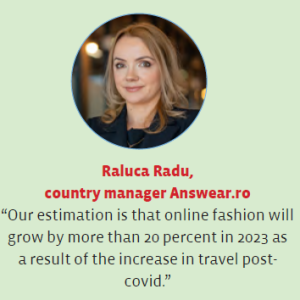
2022 was defined by the great comeback, when people finally came out of their homes after the pandemic years, seeking new experiences and wanting to catch up on their postponed travel plans. For eMAG, that meant a change in the structure of users’ shopping baskets, which contained a different mix of products: for example, instead of TV sets or furniture, they started buying more fashion or personal care items.
“Amid inflation circumstances, we made some business decisions to help our customers better navigate the complexity of an unpredictable environment, of which I would mention a few: we maintained the price for the Genius subscription unchanged and expanded the benefits of the subscription; We standardised the price for easybox deliveries irrespective of where the customer’s order comes from—whether it’s eMAG or a seller on the Marketplace,” says Irina Pencea, VP of Marketing at eMAG, adding that about 60 percent of orders today are delivered through the easybox system.
Asked about consumer behaviour, Pencea says that one of the changes that emerged during the pandemic had to do with the structure of the shopping cart: consumers started purchasing more products from different categories during a single session. “This trend is here to stay. At the same time, they’ve become more interested in flexible services that can help them save time and money.” Pencea adds that flexibility was a keyword in 2022.
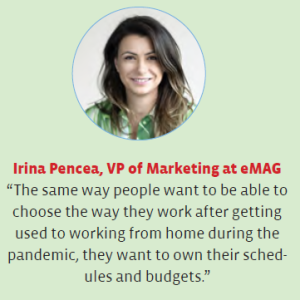
“The same way they want to be able to choose the way they work after getting used to working from home during the pandemic, they want to own their schedules and budgets and thus quickly embrace services that give them personal space and flexibility.” In 2021, eMAG announced a three-year investment plan worth RON 3.2 billion, having invested over RON 1 billion over the past year alone. One key pillar of its strategy is strengthening its logistics capabilities. After completing a EUR 43 million investment in technology at its warehouse in Joita, Giurgiu County last year, the retailer is building a new warehouse in Hungary near Budapest—its first one outside Romania. Last but not least, “our Marketplace ecosystem remains a top priority and we aim to continue building it up in order to increase the number of products on the platform as well as support the sellers’ international expansion.” Currently, over 42,000 retailers are using the Marketplace platform to boost their sales in Romania, Bulgaria, and Hungary. “Our aim is for the number of products on the platform to exceed 18 million in Romania alone, and that can only be achieved by attracting more entrepreneurs to our platform; therefore, the Marketplace will be a key driver of our business in the year ahead.”
Talking about the specifics of online fashion shopping, Radu of Answear says there were several noticeable trends after pandemic restrictions were lifted, including a surge in categories like high-heeled shoes, dresses, sneakers, and coats. Additionally, the average order value also increased by more than 40 percent. As for trends that might emerge this year, Radu expects an increase in the use of alternative payment methods such as Buy Now Pay Later. “We believe that segments like fashion, beauty products, and everything connected to travel will be on an upward trend this year,” she adds. The company aims to expand its brand portfolio in 2023, mainly with Scandinavian and premium brands. “We will also continue to invest in the development of the Answear LAB brand as well as in diversifying payment and delivery methods for our customers in order to offer them better services. We’re taking various approaches into account in order to improve our delivery times,” Radu of Answear concludes.
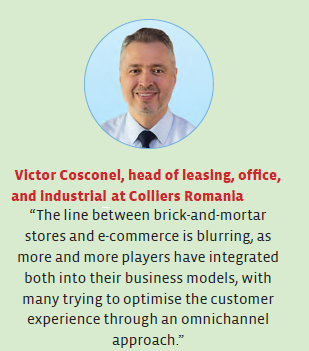
“The line between brick-and-mortar stores and e-commerce is blurring, as more and more players have integrated both into their business models, with many trying to optimise the customer experience through an omnichannel approach. Interestingly enough, with the exception of Hungary (which has a smaller share), about one in two people in the CEE-6, if not more in some countries, tend not to shop online because they would rather see the product before they make the purchase. Nevertheless, this (possibly) cultural reluctance around online shopping is exactly why a BOPIS (buy online, pick up in-store) approach may work quite well in the CEE region,” says Victor Cosconel, head of leasing, office, and industrial agencies & member of the board at Colliers Romania.
Malls: shopping experience is crucial

“It’s already been 3 years during which retailers have focused on surviving, and they need to bring freshness into the experiences they provide. Generation X is getting jobs, and their consumption behaviour is different from the millennials’; they pay much more attention to a brand’s efficiency, values, and mission. Therefore, we believe that many retailers will be focusing on their sustainability strategies in a bid to attract these consumers,” says Sebastian Mahu, Head of Asset Management at IULIUS.
Last year, the IULIUS portfolio was expanded with two proximity retail projects under the Family Market brand, in Iasi. The company is now operating a retail area that exceeds 325,000 sqm, including two mixed-use urban regeneration projects—Palas Iasi and Iulius Town Timisoara—, the Iulius Mall regional shopping network in Iasi, Cluj-Napoca, and Suceava, as well as the two Family Markets.
“2022 was a year of revival, after a long period of challenges. The first quarter was still affected by the pandemic as well as by the war that broke out on Romania’s border. In the second part of the year, we saw increases of more than 50 percent in the retail segment against 2021. In terms of footfall, as expected, the results show a comeback in terms of shopping behaviour, reaching levels comparable to those of 2019. As compared to 2021, footfall increased by an average of 23 percent. Our projects¬—which are defined by the synergy between functions such as offices, park, entertainment, services, and retail—are also strongly anchored in the life of the community, and their footfall levels had risen above the market average even during the pandemic,” Mahu explains. As for the retailer mix, he notes that the IULIUS projects have a high degree of maturity and an occupancy rate of over 98 percent, so any fluctuations are related to optimising and updating the tenant portfolio in response to consumption behaviours. “In 2022 we had more than 60 new store openings and several relocations and refittings.”
Mahu believes that consumers this year will continue to seek efficiency and focus more on discounts, promotions, and good prices, given the pressure of inflation. “In addition, the need for emotional connection and networking will deepen in 2023, and we will find this being reflected in the shopping experience, as physical retail holds this advantage.” He adds that it will become more challenging for retailers to enter new markets, due to high initial investment costs. Yet,“in terms of profitable segments, we expect last year’s trends to continue in 2023, so areas like sports, health & beauty, and food should see some of the highest growth levels.”
Electroretail: a more mature and sophisticated market

The electro-retail market continued its growth in 2022, albeit at a slower pace, with specialists estimating a single-digit expansion compared to 2021. One of the main reasons was the fact that customers could freely return to malls and shopping centres.
“2022 brought several challenges, but even in the difficult macroeconomic context, Altex managed to consolidate its growth through more efficient processes and an improved customer experience. Our company was able to attract new customers, consolidate its position as a specialist in the electro-IT sector, and add new categories of products to its portfolio,” says Raul Filip, acquisitions director at Altex. The company has an omnichannel approach that provides customers with a wide range of products and services available for all channels: online, mobile app, and offline. In 2023, Altex aims to expand its store network with 14 new stores by the end of the year, as well as modernise some of its existing ones. According to Filip, one of the biggest challenges the company now faces is building the Altex Marketplace as a modern and innovative shopping solution that aligns with its values and quality of customer experience. “This year we will operate on a more mature and sophisticated market with a high level of volatility as customers’ expectations for quality products and services have increased. Digitalization and retail automation will certainly represent an area of focus, while technology and innovative tools will improve processes and ensure efficiency in operations,” Filip notes.
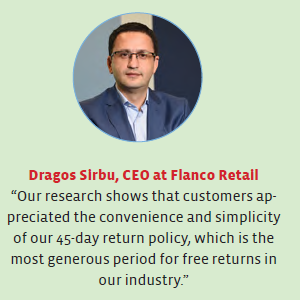
Along similar lines, Dragos Sirbu, CEO at Flanco Retail, says that his company listened to its customers’ needs more than ever last year. “Our research shows that customers appreciated the convenience and simplicity of our 45-day return policy, which is the most generous period for free returns in our industry. We’ve also deployed a faster refund policy: on the spot if the return is carried out in a Flanco store and within 24 hours if it’s via courier delivery or lockers.” Sirbu adds that the company took its slogan a step further, enabling its clients to invest in high-quality electro-IT that have long lifespans. “We were the first in our business to launch in-store installment payments using the customer’s salary card—and we did that across all of our 157 stores,” he points out. As for attracting new customers, Sirbu says that Flanco has increased its social media presence. “Considering that people have been investing more in domestic holidays and travels lately, we have laid the foundations of an OOH network aiming to increase our visibility in areas with intense traffic. We have also opened up new stores in high traffic shopping centres, all while increasing our brand visibility in the most important malls in the country.”
Courier market: players focused on expansion

Statistics show that the Romanian courier market saw continued growth in 2022, reaching a value of EUR 850 million, and expectations remain positive. “The unpredictable market circumstances have challenged the status quo, and this impacted our entire industry. Two years of pandemic restrictions followed by the armed conflict on Romania’s border changed consumption habits and brought significant volatility. We increased our ability to adapt to the business environment which we were entirely thrusted into. 2022 was a year of investments, a strategy that would usually be applied in more predictable market conditions, which we’ve lacked in recent months,” says Sameday CEO Lucian Baltaru.
“For 2023, we estimate a market growth of 10-15 percent. Retail is rapidly migrating online, so online trade was the trigger of the courier market in 2022, and it will continue to be in 2023,” says Adrian Mihai, the CEO of FAN Courier. He adds that e-commerce had a share of 60-65 percent in the company’s activity last year, especially in the context of the traditional shopping campaigns of the last two months of the year—Black Friday and the Winter Holidays.
FAN Courier’s investments last year topped at EUR 31.5 million. The company completed its second largest HUB in Romania, in Cluj-Napoca, started the modernisation and automation of its HUBs in Brasov and Stefanesti, relaunched its lockers network, and continued the digitalization and expansion of its car fleet. “We invested around EUR 10 million in relaunching and developing our smart lockers network, FANbox, and this was the biggest investment of 2022. At the moment, we have a total of about 500 lockers in Bucharest and other large cities in the country,” Mihai adds. This year, the courier firm will continue projects that it started last year, including expanding its headquarters in Stefanestii de Jos and its two HUBs, further developing its locker network, and advancing digitalization. The purchase of electric cars and investments in sustainability are also on its list of priorities.
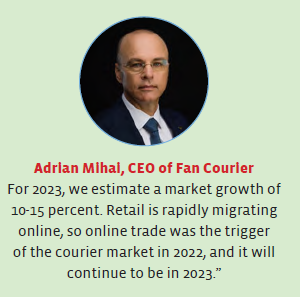
“On the international market, we plan to continue developing operations in the Republic of Moldova. We entered the neighboring country in 2021, after an initial investment of EUR 3 million. We want to attain leader status on this market as well and will continue to invest in the fleet, employees, logistics facilities, and technology following a period of uncertainty generated by the war taking place in the immediate vicinity. We are also increasingly interested in other international markets and are analysing expansion opportunities, to give customers from Central and Western Europe access to the Romanian market and vice versa,” Mihai explains.
2022 was a year of investments for Sameday as well. The company launched services that facilitated the interaction between couriers and end customers, through the Interactive Delivery Management application, and it increased its parcel management capacity, while also expanding the easybox network that today counts more than 3,700 lockers in Romania alone. “Yet our most important achievement of the year remains the expansion to Bulgaria. The international market was first tackled by Sameday in 2020, when we launched our services in Hungary, but this was only the beginning. At the moment, we have approximately 800 easybox lockers outside Romania’s borders, in Hungary and Bulgaria,” Baltaru says.
“In 2023, the focus remains on our customers and their needs, so the company is working on large-scale projects to improve the end-to-end experience, from order confirmation to package pickup. The two aces up our sleeves are acknowledging and implementing the feedback we are given and our openness to new technologies. Technology is the word that will dominate Sameday’s activity this year,” the CEO adds.
Industrial: record-breaking year
Industrial developments and leasing demand are showing no signs of a material slowdown and, in some cases, are set to remain on par with levels of previous years, which have been record-setting for some countries, argues Cosconel of Colliers Romania. “On a per capita basis, the modern industrial and logistics stock in the CEE-6 countries remains well below that of a ‘normal’ Western country, so there is still a lot of room to grow over the medium term. A country’s economic momentum as well as its infrastructure dictate how fast each market will grow,” says Cosconel. In numbers, 2022 was the best year ever for logistics players. “Totalling 1.11 million sqm, industrial transactional activity passed the 1 million sqm threshold for the first time, and was 31 percent higher than the 2021 level,” says Victor Rachita, head of industrial and logistics services at CBRE Romania.
2022 saw Romania becoming a regional hub for retail and e-commerce, with 3 transactions above 50,000 sqm, and companies such as CCC, LPP, PEPCO or H&M renting logistics space mostly in industrial developments around Bucharest. There have also been numerous new entries in the manufacturing sector, especially in the central-western part of the country, thanks to the highly qualified workforce, accessible geographical location, a stable economic and social environment, and substantial state aid.
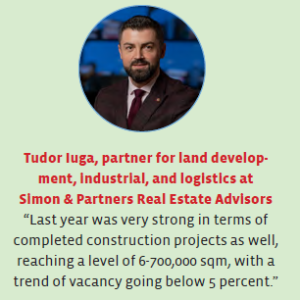
“Last year was very strong in terms of completed construction projects as well, reaching a level of 6-700,000 sqm, with a trend of vacancy going below 5 percent. This will lead to a developers’ market in the following two years across the entire country. We’re already seeing it in regions/counties such Cluj, Brasov or the north of Bucharest,” says Tudor Iuga, partner for land development, industrial, and logistics at Simon & Partners Real Estate Advisors. He adds that even though “recession” may be a key term in 2023, we should still expect the industrial sector to perform better than the other real estate segments.
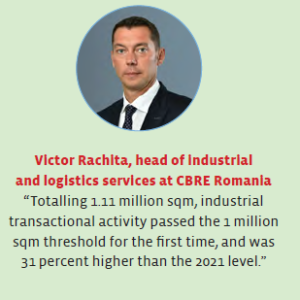
“In a year when we estimate for another 550,000 sqm to be added to the stock of modern industrial & logistics space, the market will look to benefit from Romania’s strong positioning both for the non-shoring strategy of many manufacturing companies as well as for local and regional distribution in CEE,” Rachita argues. Last but not least, local companies will consolidate their storage areas based on new volumes, which will be lower than those of 2020-2022. According to the CBRE Romania representative, the good news for this year is that the Eastern/North-Eastern region comes in third, with 18 percent of future deliveries. “Once overlooked by investors mostly due to its underdeveloped infrastructure, the region has managed to attract local investors willing to create the foundation of modern industrial stock in the area,” Rachita adds.
Elsewhere, Iuga says that yield decompression, high interest rates, high inflation, and rising construction costs will lead to a decline in new speculative construction. This will translate into rent level increases for the industrial sector. “Still, considering the supply chain challenges of the past two years, both nearshoring and friendshoring are expected to flourish in the coming period, with Romania finding itself in a very attractive position due to costs and workforce availability, by being the second biggest country in the CEE region, and having a strategic geographic position,” Iuga notes.
What did logistics players do last year?

In 2022, CTP Romania focused on expanding the parks in its portfolio, starting with Bucharest, which is increasingly emerging as a regional hub. CTPark Bucharest West, which is due to become the largest industrial park in Europe, was expanded, and so were CTPark Bucharest at km 13 and CTPark Bucharest North, in the Stefanesti-Afumati area. Recently, CTPark Bucharest West reconfirmed its position as a regional logistics hub for the whole Balkans and beyond, by starting its cooperation with LPP, the fastest growing fashion retailer in Romania, for its regional distribution centre. LPP leased 65,000 sqm of warehouse space in CTPark Bucharest West.
As for its 2023 plans, CTP is starting the expansion of CTPark Bucharest South, which represents another pin on the Bucharest map, this time in the Popesti-Leordeni area. “Our park in the south of Bucharest benefits from the best infrastructure in the area, with two direct entrances from DN4, near the ring road, but also with direct access to A0, at the junction point located at less than 500m from our new building. We already have 70,000 sqm that are fully leased, another 15,000 sqm will soon be delivered, and we’ll start the construction of an additional 60,000 sqm. With this expansion, for which all the infrastructure is already prepared, CTPark Bucharest South will reach 150,000 sqm”, says Ana Dumitrache, country head at CTP Romania.

The effervescence of the Romanian real estate market is also proven by Cometex, a developer of retail parks and member of the Altex Group. The company has 10 projects for retail parks for 2023, in cities such as Dej, Vatra Dornei, Valenii de Munte, etc. “We’re seeing online and offline as always being together. We have a different approach and development strategy, targeting all urban areas in Romania, from small towns of 20-30,000 inhabitants to large cities with over 300,000 inhabitants,” says CEO Adrian Urda.
Quotes
- Raluca Radu, country manager Answear.ro: “Our estimation is that online fashion will grow by more than 20 percent in 2023 as a result of the increase in travel post-covid.”
- Irina Pencea, VP of Marketing at eMAG: “The same way people want to be able to choose the way they work after getting used to working from home during the pandemic, they want to own their schedules and budgets.”
- Sebastian Mahu, Head of Asset Management at IULIUS: “The need for emotional connection and networking will deepen in 2023, and we will find this being reflected in the shopping experience, as physical retail holds this advantage.”
- Raul Filip, acquisitions director at Altex: “This year we will operate on a more mature and sophisticated market with a high level of volatility as customers’ expectations for quality products and services have increased.”
- Dragos Sirbu, CEO at Flanco Retail: “Our research shows that customers appreciated the convenience and simplicity of our 45-day return policy, which is the most generous period for free returns in our industry.”
- Lucian Baltaru, CEO of Sameday: “Our most important achievement of the year remains the expansion to Bulgaria. The international market was first tackled by Sameday in 2020, when we launched our services in Hungary.”
- Adrian Mihai, CEO of FAN Courier: “For 2023, we estimate a market growth of 10-15 percent. Retail is rapidly migrating online, so online trade was the trigger of the courier market in 2022, and it will continue to be in 2023.”
- Victor Cosconel, head of leasing, office, and industrial agencies & member of the board at Colliers Romania: “The line between brick-and-mortar stores and e-commerce is blurring, as more and more players have integrated both into their business models, with many trying to optimise the customer experience through an omnichannel approach.”
- Victor Rachita, head of industrial and logistics services at CBRE Romania: “Totalling 1.11 million sqm, industrial transactional activity passed the 1 million sqm threshold for the first time, and was 31 percent higher than the 2021 level.”
- Ana Dumitrache, country head at CTP Romania: “Our park in the south of Bucharest benefits from the best infrastructure in the area, with two direct entrances from DN4, near the ring road, but also with direct access to A0.”
- Adrian Urda, CEO Cometex: “We have a different approach and development strategy, targeting all urban areas in Romania, from small towns of 20-30,000 inhabitants to large cities with over 300,000 inhabitants.”
- Tudor Iuga, partner for land development, industrial, and logistics at Simon & Partners Real Estate Advisors: “Last year was very strong in terms of completed construction projects as well, reaching a level of 6-700,000 sqm, with a trend of vacancy going below 5 percent.”



:quality(80)/business-review.eu/wp-content/uploads/2024/07/vodafone-RO.jpg)



:quality(80)/business-review.eu/wp-content/uploads/2024/06/22C0420_006.jpg)

:quality(80)/business-review.eu/wp-content/uploads/2024/06/COVER-1-4.jpg)



:quality(80)/business-review.eu/wp-content/uploads/2024/06/br-june-2.jpg)
:quality(50)/business-review.eu/wp-content/uploads/2024/07/BeFunky-collage-37-scaled.jpg)
:quality(50)/business-review.eu/wp-content/uploads/2024/07/04_ThinkPad_T14s_6_Business_Coworking.jpg)
:quality(50)/business-review.eu/wp-content/uploads/2024/07/Iulia-Surugiu-scaled.jpg)